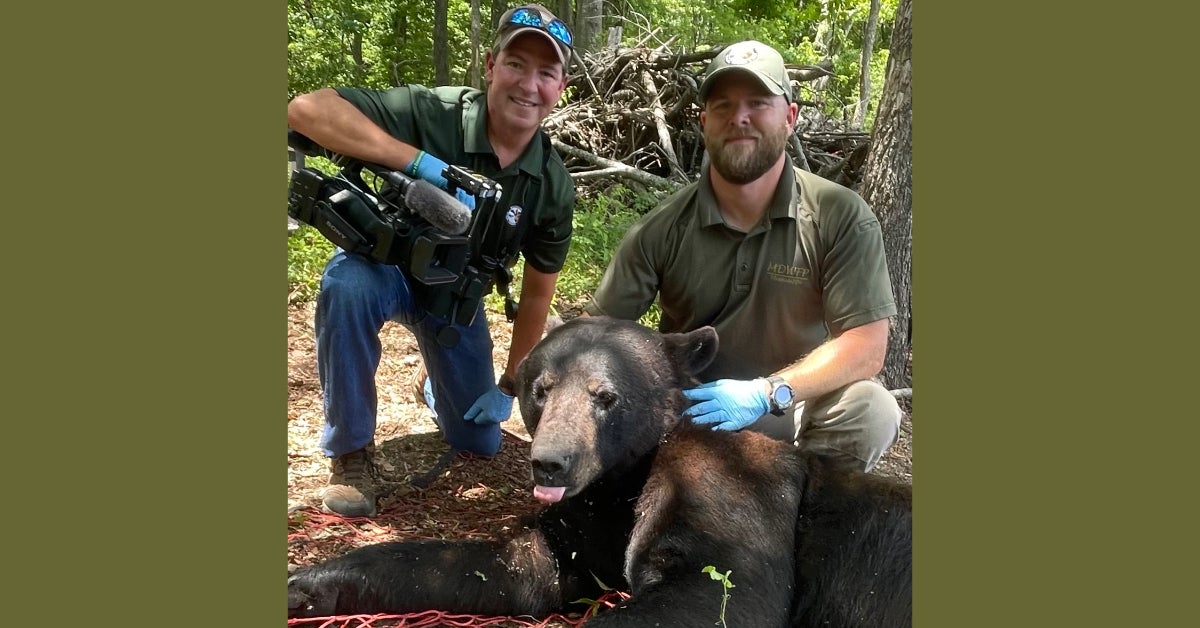Could Mississippi have a bear hunting season? Here’s what we know.
Published 2:04 pm Wednesday, October 18, 2023

- Scooter Whatley and Anthony Ballard with a tranquilized black bear which was collared for black bear research. Ballard is the Mississippi Black Bear Program Director. Whatley is a native of Vicksburg and a videographer for the MDWFP. (Submitted Photo | Scooter Whatley)
By Hunter Cloud | Special to The Vicksburg Post
Mississippi Department of Wildlife, Fisheries and Parks Black Bear Program had one common question asked last week: When is Mississippi getting a bear hunting season?
The question stems from Louisiana announcing it will work toward creating a new black bear season.
Bear Program Coordinator Anthony Ballard said the question of when Mississippi will have a bear season is difficult to answer. Black bears are native to Mississippi, Louisiana, Texas, Arkansas and Tennessee. Unregulated hunting and loss of habitat in the late 1800s drove the bear population down to threatened levels.
Additionally, Ballard said he often gets asked how many bears Mississippi has. Mississippi’s best estimate for its bear population at the start of the bear program was 50 bears, and the state does not have an up-to-date estimate yet.
The population question must be answered before determining a hunting season for bears in Mississippi. However, Ballard said, much fieldwork was completed during the summer to better answer those questions.
“To have a hunting season, you have to figure out how much of the population you can take away to have a stable population,” he said. “We are trying to figure out our population because our estimate is outdated. All I can do is guess on a population until we get a good estimate.”
Data has been collected through hair snare sampling in a multi-state project with Louisiana, Arkansas and Tennessee. The states are pooling genetic data to look at the population’s demographics like the sex and age makeup of the bears.
The pieces will be put together to make a puzzle. MDWFP has the data now, but Mississippi State University’s College of Forest Resources will need to analyze the data before any conclusions can be drawn from the hair snare research project. MSU serves as the unofficial research arm of MDWFP. Ballard said he is not sure how long the MSU analysis will take.
Strong trapping season
Ballard said the department undertook a research project to collar several bears this summer and collared 22 black bears. He managed to trap 12 bears himself. Ballard said he wanted to highlight the ingenuity it took to accomplish the collaring project.
“We have done a lot of work this summer. I’m proud of how I built a trap to integrate the livestream cameras we used for trapping hogs. It is one of those things where it is a game-changer for trapping bears,” Ballard said.
He previously oversaw the Wild Hog program for MDWFP and handles nuisance animals such as coyotes. HogEye is the livestream camera made in Mississippi used to trap hogs. Ballard took the camera and fabricated his own trap to use it. He said a fabricating company wanted thousands of dollars for the project, so he took it upon himself to build his own trap for much less.
Mississippi previously used what is called a culvert trap. It looks like a big metal pipe and is set off by a pressure panel inside. Ballard said there are some days when the heat causes an unsafe situation, so having livestream cameras helps in making the decision to trap.
His new trap is made to where bears can see out of it and thus do not feel as confined. Wires for the livestream camera and other electronics are in a conduit, so bears are unable to chew on wires. The trap is part of a trailer. Ballard said all he has to do is drop the jacks and leave it standing.
“I built the trap out of a whole bunch of metal, welding, cutting and sweat in the process,” Ballard said. “I can drop the trap on my command and select for particular individuals. If a bear is already collared, you can avoid trapping them. Or if a dangerous situation, such as a sow with a cub comes along, you may not want to drop the trap. It gives you a level of control you can not get anywhere else.”
Traps have traditionally been baited with day-old doughnuts thrown out by bakeries, but Ballard made an adjustment this year. He noticed bears in Mississippi preferred corn and protein feed found in deer feeders.
Feed is placed in the bear traps in addition to a scented lure like vanilla to help sweeten the pot. Bears have a strong sense of smell, seven times better than a dog, and the scent lures help catch their attention. Ballard would often play the wind to where the scent would blow to where bears were thought to be.
Ballard said he learned to weld while working for the Louisiana Department of Wildlife and Fisheries. A guy who worked there asked him if he wanted to learn how to weld. Ballard was taught how to stick and wire weld. He built some hog traps for the LDWF, which gave him some familiarity with the system.
“I go to high schools, middle schools and colleges to speak, and I tell them if there is anything they can learn to do, just learn it,” Ballard said.
Bear surprises
Over the past year, Ballard said he has seen two surprises. One is the density of bears. He knew there were many bears in Southwest Mississippi in Wilkinson and Claiborne counties, but didn’t realize just how many.
“From Utica to Port Gibson I didn’t realize exactly how many bears there were. It was a surprise. I collared five there in a 15- to 20-mile stretch. It was a surprising density,” Ballard said.
Most of the bear density in Claiborne County is along the Bayou Pierre. It makes sense, as bears and most other animals use drainages and waterways as travel corridors. MDWFP collared a 200-pound male a few miles from Alcorn State University. Ballard said the bear had made its way through Canemount Wildlife Management Area and the Windsor Ruins.
Clarke County has a pretty good bear density as well, based on public posts in the Mississippi Bear Photos Facebook group. Ballard said another surprise to him was finding bears in Noxubee and Atalla County, where habitat gets pretty sparse.
Mississippians have contributed to the bear program research by reporting sightings of bears. In 2022, people reported 70 bears, and the number doubled to 150 black bear sightings so far in 2023. MDWFP unveiled an interactive map featuring these observations earlier this year.
“I attribute the growth more to public awareness. They know what to do and it has helped gather more data,” Ballard said. “It helped the public understand that bears are still out there.”
Synopsis of the Bear Program
MDWFP’s next commission meeting is Nov. 16, when Ballard will present on the bear program for an educational session starting at 9 a.m. The meeting will be at the MDWFP Headquarters in Jackson.
It will be a year in review for Ballard, as he unofficially took the reins of the bear program in November 2022 before getting his official start in January.
“The session will be more of an update on the trapping we have done with MSU and what we have done since I took over,” Ballard said. “I’ll get to talk about how we have moved the bear program forward.”





